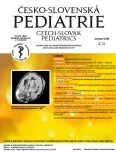Possibilities of pharmacotherapy of depressive disorder in children and adolescents
Authors:
J. Trebatická; J. Šuba
Authors‘ workplace:
Klinika detskej psychiatrie, NÚDCH a LFUK, Bratislava, Slovensko
Published in:
Čes-slov Pediat 2019; 74 (4): 211-215.
Category:
Overview
Depressive disorder belongs to the mood disorders. It occurs also in children and adolescents. The prevalence of depressive disorder is reported in the literature in approximately 6–12 years-old, around 2.8% and in adolescents 5.6–6.9%. Children are more likely to experience depressive symptoms that do not fulfill the diagnostic criteria for depressive disorder in adult age.
The treatment of depression in children and adolescents consists of a combination of psychopharmacotherapy and psychotherapy. In the treatment the severity of the symptoms of depression should be assessed, as well as the preference of the patient and parents of the patient, the developmental level of the patient, the associated risk factors, and the availability of medical services. Most of the guidelines for the treatment of depression in child psychiatry recommend psychotherapeutic interventions as the first choice. Antidepressant (AD) from the SSRI group fluoxetine should only be considered in patients with moderate to severe depression (especially in adolescents) who do not have access to psychotherapy or do not have a positive response on it. According to the current SPC in Slovakia, only fluoxetine (SSRI) can be used for the treatment of depression. It is allowed from the age of 8 years in the indication of moderate or severe depression.
Keywords:
depressive disorder – pharmacotherapy – children and adolescents
Sources
1. Costello JE, Erkanli A, Angold A. Is there an epidemic of child or adolescent depression? J Child Psychol Psychiatry 2006; 47 (12): 1263–1271. https://doi.org/10.1111/j.14697610.2006.01682.x
2. Wittchen HU, Jacobi F, Rehm J, et al. The size and burden of mental disorders and other disorders of the brain in Europe 2010. Eur Neuropsychopharmacol J Eur Coll Neuropsychopharmacol 2011; 21 (9):655–679. https://doi.org/10.1016/j.euron euro.2011.07.018
3. Coghill D, Bonnar S, Duke SL, et al. Child and Adolescent Psychiatry. Oxford: Oxford University Press, 2009 : 1–491.
4. Thapar A, Collishaw S, Pine DS, Thapar AK. Depression in adolescence. Lancet. 2012; 379 (9820): 1056–1067.
5. Clark MS, Jansen KL, Cloy JA. Treatment of childhood and adolescent depression. Am Fam Physician 2012 Sep 1; 86 (5): 442–448.
6. Wesselhoeft R, Heiervang ER, Kragh-Sørensen P, et al. Major depressive disorder and subthreshold depression in prepubertal children from the Danish National Birth Cohort. Compr Psychiatry 2016 Oct; 70 : 65–76. doi: 10.1016/j.comppsych.2016.06.012. Epub 2016 Jun 23.
7.US Food and Drug Administration. Suicidality in children and adolescents being treated with antidepressant medications. Oct 15, 2004. www.fda.gov/safety/medwatch/safetyinformation/safetyalertsforhumanmedicalproducts/ucm155488.htm (accessed Oct 18, 2015).
8. Li X, Frye MA, Shelton RC. Review of pharmacological treatment in mood disorders and future directions for drug development. Neuropsychopharmacology 2012 Jan; 37 (1): 77–101.
9. Hazell P, Mirzaie M. Tricyclic drugs for depression in children and adolescents. Cochrane Database of Systematic Reviews 2013, Issue 6. Art. No.: CD002317. doi: 10.1002/14651858.CD002317.pub2.
10. Hetrick SE, McKenzie JE, Cox GR, et al. Newer generation antidepressants for depressive disorders in children and adolescents (Review) 7, Cochrane Library 2012, Issue 11, Copyright© 2012 The Cochrane Collaboration. Published by JohnWiley & Sons, Ltd.
11. Cipriani A, Zhou X, Del Giovane C, et al. Comparative efficacy and tolerability of antidepressants for major depressive disorder in children and adolescents: a network meta-analysis. Lancet 2016; 388 : 881–890. https://doi.org/10.1016/s0140-6736(16)30385-3.
12. Ondrejka I. Liečba psychofarmakami v detskom a adolescentnom veku. In: Pečeňák J, Kořínková V, a kol. Psychofarmakológia. Wolters Kluwer s.r.o., 2016 : 1–666. ISBN 978-80-8168-542-2.
13. Cipriani A, Furukawa TA, Salanti G, et al. Comparative efficacy and acceptability of 21 antidepressant drugs for the acute treatment of adults with major depressive disorder: a systematic review and network meta-analysis. Lancet 2018; 391 (10128): 1357–1366. https ://doi.org/10.1016/S0140 -6736(17)32802-7.
14. Cheung AH, Zuckerbrot RA, Jensen PS, et al. Guidelines for Adolescent Depression in Primary Care (GLADPC): Part II. Treatment and Ongoing Management. Pediatrics 2018; 141 (3): e20174082.
15. National Institute for Health and Care Excellence (NICE) 2017. All rights reserved. Subject to Notice of rights (https:/www.nice.org.uk/terms-and-conditions#notice-of - rights).
16. Cheung AH, Kozloff N, Sacks D. Pediatric depression: an evidence-based update on treatment interventions. Curr Psychiatry Rep 2013; 15 (8): 381. https ://doi.org/10.1007/s1192 0-013-0381-4.
17. Hopkins K, Crosland P, Elliott N, Bewley S, Clinical Guidelines Update Committee B. Diagnosis and management of depression in children and young people: summary of updated NICE guidance. BMJ 2015; 350: h824. https://doi.org/10.1136/bmj.h824.
Labels
Neonatology Paediatrics General practitioner for children and adolescentsArticle was published in
Czech-Slovak Pediatrics

2019 Issue 4
Most read in this issue
- Specific aspects of posttraumatic stress disorder in childhood and adolescence
- Psychiatric disorders with predominance of somatic symptoms in childhood and adolescence
- Possibilities of pharmacotherapy of depressive disorder in children and adolescents
- The role of maternal autoantibodies in the pathogenesis of autism spectrum disorders
